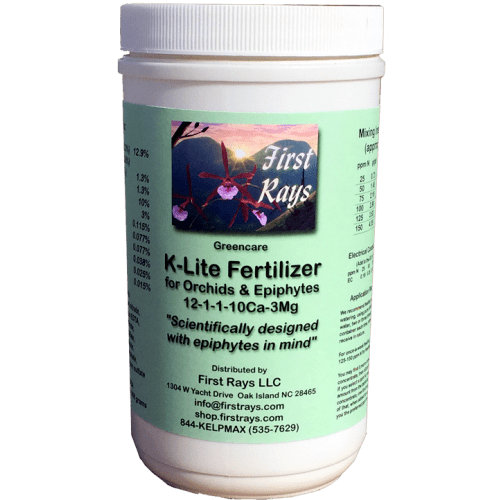
NOVEL FORMULA MIMICS THE NUTRIENTS
ORCHIDS & OTHER EPIPHYTES SEE IN NATURE
Ninety-five percent of a plant is water. Of the remaining five percent, the majority is carbon, hydrogen, oxygen (obtained from air and water), and nitrogen. All the other minerals, combined, amount to only about one percent of a plant’s mass. Based upon broad scientific data, K-Lite Orchid/Epiphyte Fertilizer (12-1-1-10Ca-3Mg) seeks to provide a complete array of nutrients at levels and relative concentrations appropriate for the physiological demands of these unique plants.
Derived from the Greencare Orchid Special for RO Water formula (the original “MSU Fertilizer”), K-Lite Orchid/Epiphyte Fertilizer has reduced potassium and phosphorus levels with enhanced calcium and magnesium content, with a complete array of essential minor elements. Studies have suggested that excessive potassium, whether applied-, obtained from-, or accumulated in growing media, can have a negative impact on the health of plants, especially in the absence of adequate calcium and magnesium. Excessive potassium can exacerbate deficiencies in those essential nutrients by preventing them from being adequately absorbed. Calcium and magnesium have been added to compensate for water supplies that do not contain sufficient quantities, while remaining compatible with those that do.
The K-Lite formula mimics the nutrient mix provided by the combination of host plant exudates and accumulated airborne particulates that are flushed down from the forest canopy whenever it rains. The low dosing provides plenty of nutrition for these slow-growing plants, while avoiding root damage or the buildup of mineral residues and wastes.
Fertilizer Application Recommendations:
We recommend feeding at 25 ppm N at every watering, using pure water, two or three times per week or more, flooding the plants each time, mimicking what they receive in nature.
For once-a-week feeding, use 75-100 ppm N, or as much as 150-200 ppm N for feeding every two or three weeks.
You may find it more convenient to make a liquid concentrate, then dilute that for use. For example, if you select a target ppm N for your regimen, then mix 128 times that amount to make up a gallon of concentrate, one fluid ounce (two tablespoons) of that solution, when added to a gallon of water, will give you the target nitrogen concentration for application.
